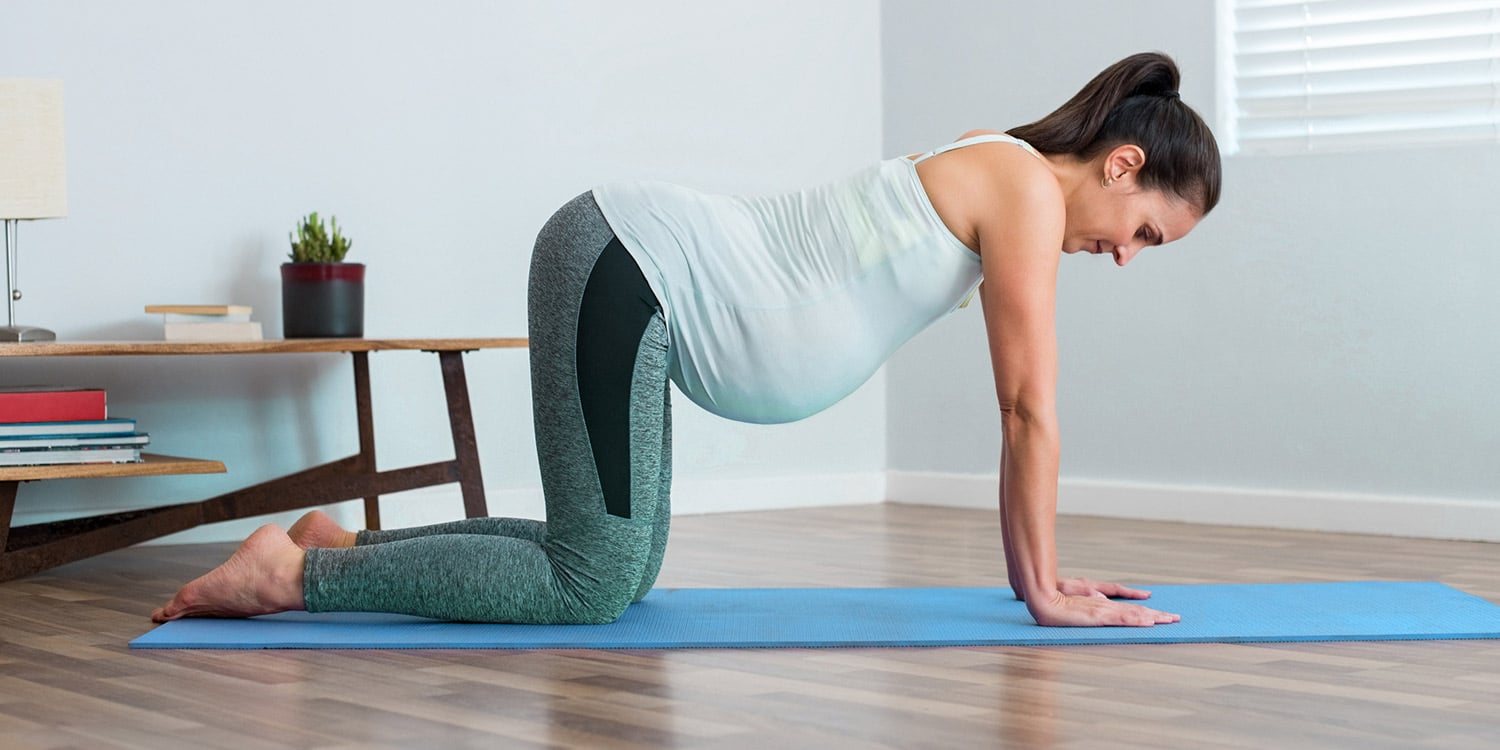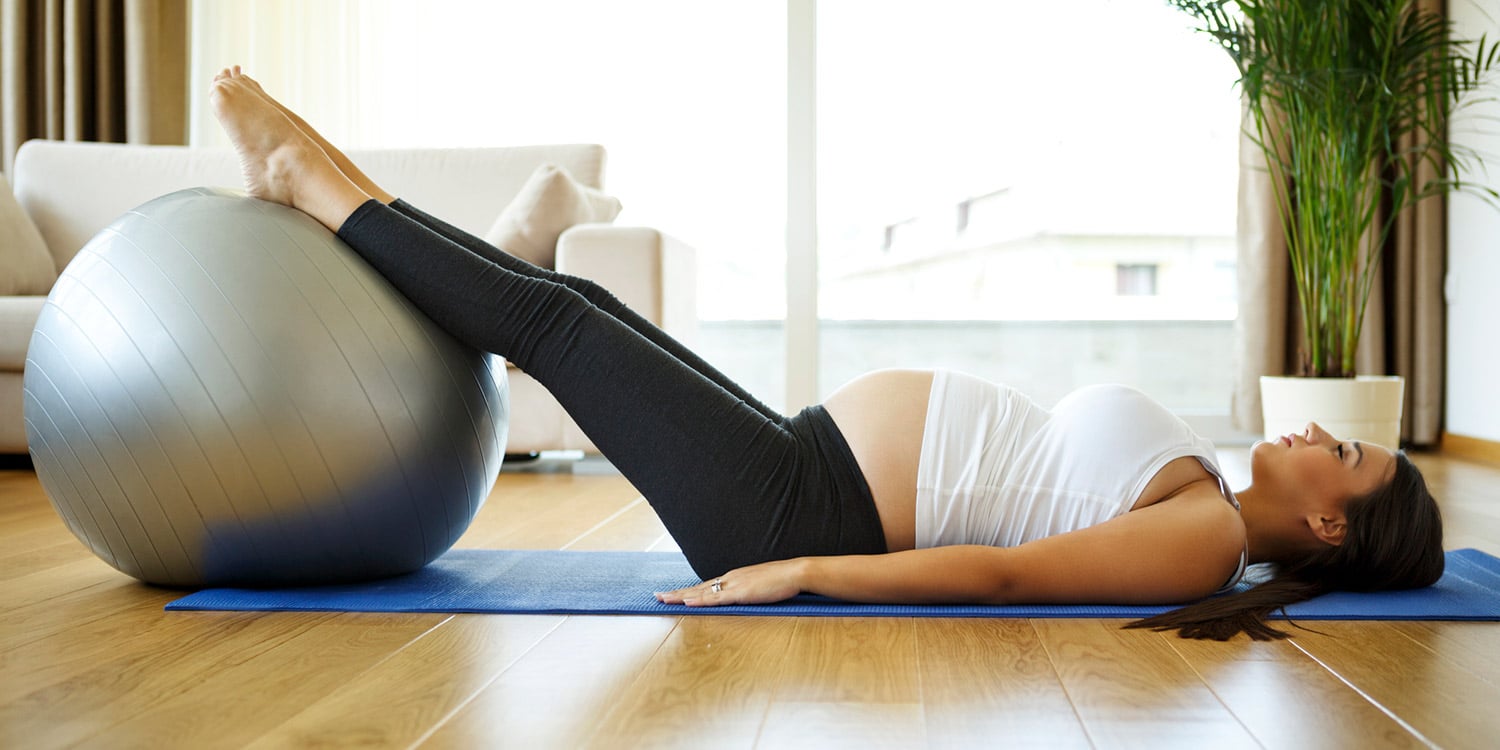The best exercises for pregnant and postpartum women

We asked fitness experts for their top tips for staying in shape during and after pregnancy.
Moving while you’re pregnant is so important. It can be five minutes in the morning or ten minutes at lunch. The time of day doesn’t matter, just as long as you can fit it into your schedule.
Being fit as a mother doesn’t mean spending hours at the gym. We talked with Jaime McFaden, a mom and trainer with audio fitness app Aaptiv, and asked for her top tips for staying in shape during and after pregnancy. Check out her lists of the best exercises for pregnant women, and the best exercises for postpartum women, below.
In this article:

The best exercises for pregnant women
Regular exercise during pregnancy can improve health, reduce the risk of weight gain and even help with delivery. Jaime says that while it’s important to move throughout your pregnancy, it is also important to listen to your body. During pregnancy, your body goes through so many changes. Before doing any intense physical activity during pregnancy, listen to what your body is telling you.
Below are some safe exercises for pregnant women.
Kegel exercises for pregnant women
Kegel exercises are something you should do every day even if you’re not pregnant, Jaime says. Learning how to contract and release your pelvic muscles is so important for women’s bodies. This exercise can be done anywhere and only takes a couple of minutes.
How to do kegel exercises: In a seated position or standing up, take a deep breath in. In the inhale, release muscles in the pelvic region, and when you exhale, clench up those pelvic floor muscles. These are the muscles that control urine flow. Repeat this exercise for about 2-3 minutes.
Recommended reps: Every day for 2-5 minutes
Ab exercises for pregnant women
The ab exercises you do should vary throughout your pregnancy. Listen to your changing body. Jaime says to “avoid crunches, laying on your back and any twisting exercises as you progress in pregnancy.” Below are three recommended ab exercises for pregnant women.
Bird dog
How to do it: This exercise requires you to get on all fours and do opposite arm and leg extensions. Start with your right arm and left leg. Move both limbs away from your center and then pull them back in. Then, repeat.
Do the same thing with your left arm and right leg.
Recommended reps: 12-15 on each side
Knee side planks
How to do it: Lay on your side with your knees bent on top of each other at a 90-degree angle. Raise your upper body by lifting yourself up on your right forearm. Your elbow should be directly under your shoulder bent at a 90-degree angle.
To do a rep, contract your abdominal muscles and lift your hips off the ground. Hold this for 30 seconds and then lower yourself to your starting position. Do this same movement on the other side.
Recommended reps: Hold each side for 30 seconds
Reverse plank
How to do it: Sit on the floor with your legs extended in front of you.
Place your palms on the floor behind your hips. Press into your palms and lift your body upwards. Looking up at the ceiling, make sure to point your toes and keep your arms and legs straight. Keep your body in a straight line and squeeze your core muscles.
Hold this for 30 seconds and repeat on the other side.
Recommended reps: Hold each side for 30 seconds
Lower body exercises
“Building lower body strength is a huge help when it comes to labor and delivery,” says Jaime. Strong lower body muscles will also help with all the lifting and carrying you will be doing as a mom. Squats are a great option. They not only keep you strong and healthy, but they also help build the muscles you will be using during birth.
Below are some exercises to help strengthen your lower body.
Pilé squats
How to do it: A pilé squat is a version of a squat where you keep your legs wide and toes turned to the outside. To do a rep, lower down your hips as you were going to sit in a chair and come back to a stand.
Recommended reps: 12-15
Lunges
How to do it: Standing with your feet hip-width apart, take a big step forward with your right leg. Lower your body until your right thigh is parallel to the floor and your right knee is directly above your right foot. Press your weight into your right heel to drive yourself back up to your starting position. Repeat this on the other side.
Recommended reps: 12-15 on each side
Back exercises for pregnant women
Most women endure back pains at some point in their pregnancy. “So much of what you will do as a mom is forward—make sure you build your back muscles to keep good posture and support,” Jaime says. Below are her top recommended back exercises for pregnant women.
Good morning
How to do it: Stand with your feet shoulder-width apart and place your hands behind your head. Take a deep breath and hinge forward from your hips. Allow a slight bend in the knees and keep your back flat. Lean forward until you are horizontal (do not go beyond horizontal).
You should feel a slight stretch in your hamstrings and back. Then, exhale as you reverse the move to stand up. You can do this exercise without weight, with a resistance band or with a barbell once you get comfortable.
Recommended reps: 12-15
Deadlift
How to do it: This exercise requires a barbell. Again, listen to your body and reduce your weight as needed. Between 22 and 30 weeks, consider switching to an alternative exercise as your bump may be too big.
To do this exercise, stand next to the barbell and hold a neutral spine. Taking a deep breath, bend from the hips (maintaining a neutral spine), and grab the barbell. Exhale as you lift up.
Once you are at your starting position, breathe in on the way down until your barbell is back on the ground. As you exhale, repeat the exercise by lifting the barbell back up.
Remember to keep a neutral back throughout.
Recommended reps: 12-15
One-arm row
How to do it: With a 5-10 pound weight in your left hand, place your right knee on a sturdy chair and leave your left foot on the ground. Bend forward with your back parallel to the floor and place your right hand on the seat.
Hold the weight in your left hand with your palm facing in and extend down. Bend your left elbow back up to form a 90-degree angle. Hold for a couple of seconds and then return to your starting position. Repeat this on both sides.
Recommended reps: 12-15 on each side
Yoga exercises for pregnant women
Yoga is a great way to condition the body and soothe the mind during pregnancy. “I strongly advise women even if they have never tried yoga to give it a try during pregnancy,” says Jaime.
However, it is important to not over-stretch. During pregnancy, your body will produce more of the hormone relaxin. This hormone has a tendency to make you feel more limber than you are.
With that in mind, try out the exercises below. These poses are great for any stage of your pregnancy as they do not include a ton of twisting or balance.
Cat cow
How to do it: This move is great for stretching your back, releasing tension and shifting the weight of the baby away from your spine.
To do the cat cow pose, start on your hands and knees with your hands directly under your shoulders and your knees directly under your hips. As you inhale, raise your head slowly and look up. On your exhale, bring your chin towards your chest and round your back. Press your hands into the floor and push the center of your back up (similar to a cat stretching).
Recommended reps: 3-4 breaths
Downward dog
How to do it: To do this pose, start on your hands and knees. Spread your fingertips wide and tuck in your toes. From here, lift your hips up so your heels are now touching the ground and your body is in a triangular position. Press through your fingertips to draw your chest towards your thighs.
If your calves are tight, bend one knee forward and repeat with the other side. When you are done with your downward dog, you can bring your knees down and rest in child’s pose.
Recommended reps: 3-4 breaths
Pigeon
How to do it: The pigeon yoga pose is a great move for you to cool down with. For pregnant women, it is excellent for releasing tension in the lower back and hips.
To begin, start on your hands and knees. Stretch your left leg all the way back, keeping your foot relaxed. Bring your right leg forward and bend your knee, so your right knee is at your right wrist. If your belly allows, come down to your forearms and connect your hands.
Repeat this on the other side.
Any variation of this position will work and as the baby grows you may need to adjust to create space for your bump
Recommended reps: 3-4 breaths

Best workouts for pregnant women by trimester
While it is important to move throughout your pregnancy, make sure to get your doctor’s clearance before doing any exercise and check in regularly through each trimester. Jaime says the most important thing to do is to listen to your body. If you feel tired, get some rest. If you’re hungry, eat.
Your body is going through a lot of changes, so you should listen to what it’s telling you.
First trimester
According to Jaime, “the first trimester is where women either feel fine or crappy, so you have to take it day by day.” She recommends sticking to normal strength and cardio exercises.
If you didn’t do much working out before your pregnancy, aim to establish good exercise habits gradually. Start by taking a few 10-minute walks every week and then gradually build up to a 30-minute walk three to five times a week. If you are someone who exercises regularly, talk to a doctor or personal trainer about how you can lower the intensity of your workouts.
Yoga is great during this trimester as it will allow you to gently stretch and develop strength. You can also pair this with some light strength training such as squats, lunges and deadlifts.
Second trimester
In months four to seven of your pregnancy, many women generally feel great. “As the baby gets bigger and your belly starts to grow,” Jamie says, “you may surprisingly feel good and have some energy back so you can exercise.”
She recommends doing about 60-70% of what you are used to. Rather than focusing on a particular area, stick to full body workouts. When doing your abs, lower body and back exercises stick to 10-12 reps as opposed to 15.
Third trimester
You’re now in the home stretch with only a few more weeks to go! This is when your body is being stretched and pushed the most. Many women feel they need a break during this time.
However, if you are still looking to get your heart rate up, Jaime recommends avoiding exercises where you are on your back. “A vein pumping blood called the Vena can be disrupted if you lay on your back for extended periods of time,” she explains.
Avoid any high-intensity workouts. Consider activities like walking, swimming or prenatal yoga. If you’re looking to tone muscles, stick to squats and lunges. As always, make sure you are practicing your kegels.

Postpartum exercises
If you’ve just welcomed a new baby into your life, finding the time to workout can be tricky and feeling comfortable in your body again can feel even harder. “Doctors say not to go for physical exercise until 6 to 8 weeks after birth,” Jaime says.
For the first few weeks after birth, your priorities should be to rest and spend time with your new baby. Your body takes several weeks to recover from the changes of pregnancy. Do not overdo it by rushing back to the gym.
If you’re ready to get back in shape, start making an effort to move a little bit every day. Once you are feeling comfortable again, try the below postpartum exercises.
Kegel exercises postpartum
Just like you should be doing kegel exercises during your pregnancy, you should also be doing them postpartum. During the birthing process, these muscles are weakened and therefore should be exercised regularly after giving birth.
However, it is important to give your body the time it needs to heal so wait until about six weeks after delivery. You may find that doing kegel exercises is challenging at first. Do not be discouraged. This is normal and will take time and patience to get back to normal.
Low-impact exercises
If you are just starting out, it is best to begin with lower-impact activities. These can include swimming, walking, stretching, water aerobics or yoga. If you are going to the gym, try the elliptical, stationary bike or stair climber for a lower-impact workout that will still get your heart racing. Start with 5-10 minutes and then build on your duration and intensity the more comfortable you feel.
Core strengthening
According to Mahri Relin, founder of the exercise platform Body Conceptions and a trainer who specializes in postnatal workouts, “core strength keeps you safe, centered, and prepared for childbirth—and it’s the same area you want to keep strong after.” One way to regain your stability and heal your abdominal muscles is to do postpartum exercises that strengthen your core.
However, it’s important to get the green light from your MD before attempting these core exercises. Your abdominal muscles have gone through a lot of pulling and stretching in order to make room for your new baby. Avoid traditional ab workouts like sit-ups and crunches and instead opt for the abdominal exercises below.
Leg and arm extensions
How to do it: Starting on your hands and knees, draw the core up and bring your right elbow into your right knee. As you inhale, reach your right arm out and your left leg straight behind you. Exhale, and contract your muscles while bringing your right arm and left leg back to your center. That’s one rep.
Once you have completed your reps, switch sides.
Recommended reps: 10-12 each side
Yoga boat
How to do it: Sit on the floor with your knees bent. Tighten your abdomen and slightly lean your torso back while lifting your feet off the floor. Lift until your shins are parallel to the floor and your hips are flexed at 90-degrees. Keep your back straight and extend your arms forward to maintain balance.
Hold this for 30 seconds and then repeat.
Recommended reps: 10-12
Raised leg extensions
How to do it: Lie on the floor with your legs bent at 90-degrees. Engage your lower abs and lift both legs up a few inches so they are in a diagonal position. Hold for a few seconds and then return to your starting position.
Recommended reps: 12-15
Exercises for diastasis recti postpartum
Diastasis recti is a separation of the rectus abdominis, what we refer to as our “six-pack” muscles. This happens to about two-thirds of women and can occur either during or after pregnancy.
Maura Shirey, a certified pregnancy fitness educator and owner of Bodies for Birth, says that after birth “the core remains overstretched and the woman is left with a belly that feels very different.” She recommends focusing on strengthening your transverse abdominis. This is the deepest muscle in your core and your best bet for regaining strength and stability.
Kristin McGee, a yoga/pilates instructor and mother of twins, says that “while you’re healing your diastasis, you want to avoid any exercises that put too much strain on the abdominals and can cause the belly to cone or dome.” She advises her clients to avoid crunches, planks, backbends and any exercises that can cause the abdomen to stretch further. Below are some recommended exercises to help strengthen your rectus muscles.
Transverse abdominis side bracing
How to do it: Lie on your right side with your knees bent and feet resting on the floor. Place the fingers of your right hand on top of your stomach—just above the hip bone. From here, tighten your abs and draw your belly button in towards your spine.
Hold this position, then relax and repeat. You should be able to feel your muscles contract under your fingers.
Recommended reps: 3-4 breaths
Toe taps
How to do it: Lie on your back and lift your legs into a tabletop position. With your knees bent at a 90-degree angle, lift up your right leg and tap your toe on the ground. Alternate between legs.
Recommended reps: 10-12 on each side
Heel slides
How to do it: Lie on your back with your legs bent. Lengthen one leg forward and hover it over the floor, keeping the hips still and drawing your abdominals in and up. Bend the leg back into the starting position and repeat on the other side.
Recommended reps: 10-12 on each side
Postpartum back stretches
As a mother, your back muscles work harder from moving and lifting your baby all day. Many mothers begin to experience postpartum back pain. To combat this, try to do the below stretching exercises at least ten minutes a day. For the first six to 12 weeks, stick to gentle postpartum stretching such as side-to-side neck stretches or toe touches.
Pelvic tilts
How to do it: Lie on your back and bend your knees at a 90-degree angle so that your feet are flat on the floor. Then, lift your hips off the floor and squeeze your butt. You should feel a nice stretch in your lower back muscles and buttocks.
Recommended reps: 10-12
Knee to chest stretch
How to do it: Lie on your back with your legs straight in front of you. Bring one leg up and use your hands to hug your knee into your chest. Hold this for about 30 seconds and then switch to the other side.
Recommended reps: 10-12 each side
Supine lower back release
How to do it: Lie on your back with your knees bent and feet flat on the floor. Extend both arms out into a “T” position. Roll both knees to the right or left side while keeping your shoulders on the ground. Hold this for 20-30 seconds and then return to your center.
Repeat this on the other side.
Recommended reps: 10-12 each side
Busy parents and pregnant mothers should exercise whenever they find the time. Remember your body is going through a ton of changes. It’s important to listen to your body and consult a doctor before trying any of these exercises.

About Tom Anderson
Tom Anderson is an award-winning financial journalist whose work has appeared in CNBC.com, Kiplinger’s Personal Finance, Money, Monocle and Wired. He was a 2008-09 Knight-Bagehot Fellow in Economics and Business Journalism at Columbia University.
Read more by Tom Anderson
Our editorial policy
Haven Life is a customer-centric life insurance agency that’s backed and wholly owned by Massachusetts Mutual Life Insurance Company (MassMutual). We believe navigating decisions about life insurance, your personal finances and overall wellness can be refreshingly simple.
Read more
Our disclosures
Haven Term is a Term Life Insurance Policy (DTC and ICC17DTC in certain states, including NC) issued by Massachusetts Mutual Life Insurance Company (MassMutual), Springfield, MA 01111-0001 and offered exclusively through Haven Life Insurance Agency, LLC. In NY, Haven Term is DTC-NY 1017. In CA, Haven Term is DTC-CA 042017. Haven Term Simplified is a Simplified Issue Term Life Insurance Policy (ICC19PCM-SI 0819 in certain states, including NC) issued by the C.M. Life Insurance Company, Enfield, CT 06082. Policy and rider form numbers and features may vary by state and may not be available in all states. Our Agency license number in California is OK71922 and in Arkansas 100139527.
MassMutual is rated by A.M. Best Company as A++ (Superior; Top category of 15). The rating is as of Aril 1, 2020 and is subject to change. MassMutual has received different ratings from other rating agencies.
Haven Life Plus (Plus) is the marketing name for the Plus rider, which is included as part of the Haven Term policy and offers access to additional services and benefits at no cost or at a discount. The rider is not available in every state and is subject to change at any time. Neither Haven Life nor MassMutual are responsible for the provision of the benefits and services made accessible under the Plus Rider, which are provided by third party vendors (partners). For more information about Haven Life Plus, please visit: https://havenlife.com/plus
Read our disclosures
You might also like




Get our most-read stories, twice a month
My experience with Haven Life has been nothing short of fantastic from start to finish. After working tirelessly with brokers and getting quotes that were complicated to understand online, I found Haven Life and I am very pleased that I did. Haven Life’s respectful and understandable approach to issuing something as important as life insurance and doing so in such a straightforward way is why I would recommend Haven Life to my loved ones and friends alike.
Excellent and very intuitive experience! Highly recommended!
Application was simple and received sizeable approval for term life insurance without a medical exam within 48 hours. Great follow up and easy process.
Easy Breezy
Wanted to get this done for a while and this was the easiest experience I could find. I feel great knowing that there is some protection for my husband and likely dogs.
It was an easy process. The turnaround was also feasible.




